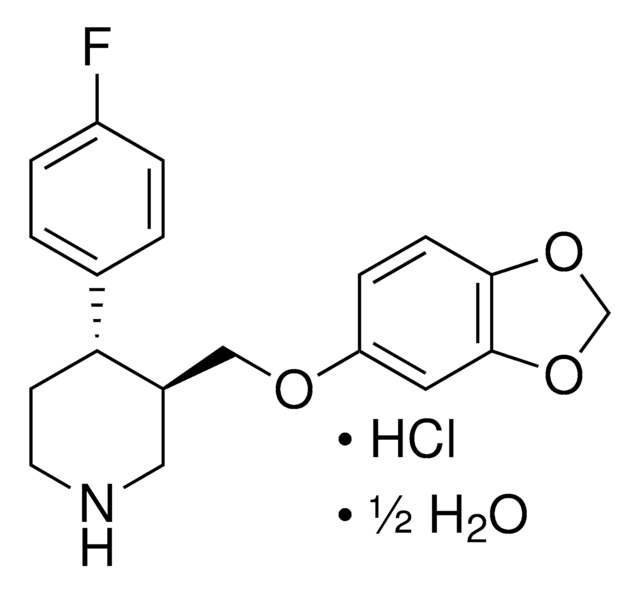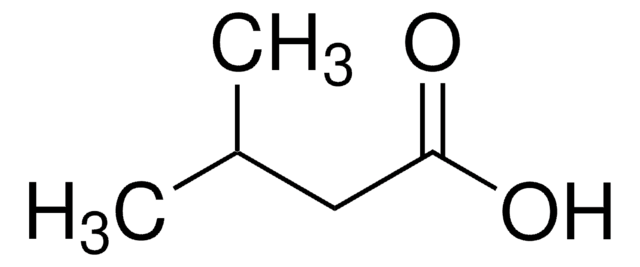P5561
Propionic acid
BioReagent, suitable for insect cell culture, ~99%
동의어(들):
Acid C3, Propanoic acid, Propanyl acid
로그인조직 및 계약 가격 보기
모든 사진(2)
About This Item
Linear Formula:
CH3CH2COOH
CAS Number:
Molecular Weight:
74.08
Beilstein:
506071
EC Number:
MDL number:
UNSPSC 코드:
12352207
PubChem Substance ID:
NACRES:
NA.71
추천 제품
Grade
reagent
vapor density
2.55 (vs air)
vapor pressure
2.4 mmHg ( 20 °C)
제품 라인
BioReagent
분석
~99%
autoignition temp.
955 °F
expl. lim.
12.1 %
기술
cell culture | insect: suitable
refractive index
n20/D 1.386 (lit.)
bp
141 °C (lit.)
mp
−24-−23 °C (lit.)
solubility
H2O: soluble
density
0.99 g/mL at 25 °C (lit.)
0.993 g/mL at 25 °C (lit.)
SMILES string
CCC(O)=O
InChI
1S/C3H6O2/c1-2-3(4)5/h2H2,1H3,(H,4,5)
InChI key
XBDQKXXYIPTUBI-UHFFFAOYSA-N
유사한 제품을 찾으십니까? 방문 제품 비교 안내
일반 설명
Propionic acid (PA) is a naturally occurring carboxylic acid, which in its pure state exists as a colorless corrosive liquid with an unpleasant odor. It is miscible in water. Industrially it is produced by hydrocarboxylation of ethylene in presence nickel carbonyl as a catalyst. PA has been found to reduce food intake, lower the fatty acids content in plasma and liver, might improve tissue insulin sensitivity and exerts immunosuppressive actions. Propionic acid is an excellent raw material as it is stable, cheap and safe and can even be used as a food additive.
애플리케이션
Use in insect cell culture to inhibit mold growth.
신호어
Danger
유해 및 위험 성명서
Hazard Classifications
Eye Dam. 1 - Flam. Liq. 3 - Skin Corr. 1B - STOT SE 3
표적 기관
Respiratory system
Storage Class Code
3 - Flammable liquids
WGK
WGK 1
Flash Point (°F)
129.2 °F - closed cup
Flash Point (°C)
54 °C - closed cup
개인 보호 장비
Faceshields, Gloves, Goggles, type ABEK (EN14387) respirator filter
이미 열람한 고객
Nucleophilic ?-Carbon Activation of Propionic Acid as a 3-Carbon Synthon by Carbene Organocatalysis
Jin, Zhichao, et al.
Chemistry?A European Journal, 21 (26), 9360-9363 (2015)
Flour and Breads and their Fortification in Health and Disease Prevention.
Victor R. Preedy, Ronald Ross Watson, Vinood B
Technology & Engineering, 476-476 (2011)
Biological effects of propionic acid in humans; metabolism, potential applications and underlying mechanisms
Sa'ad, H., et al.
Molecular and Cellular Biology, 1801 (11), 1175-1183 (2010)
Sa'ad H Al-Lahham et al.
Biochimica et biophysica acta, 1801(11), 1175-1183 (2010-08-10)
Undigested food is fermented in the colon by the microbiota and gives rise to various microbial metabolites. Short-chain fatty acids (SCFA), including acetic, propionic and butyric acid, are the principal metabolites produced. However, most of the literature focuses on butyrate
Eddy J Smid et al.
Current opinion in biotechnology, 24(2), 148-154 (2012-12-12)
Most known natural and industrial food fermentation processes are driven by either simple or complex communities of microorganisms. Obviously, these fermenting microbes will not only interact with the fermentable substrate but also with each other. These microbe-microbe interactions are complex
자사의 과학자팀은 생명 과학, 재료 과학, 화학 합성, 크로마토그래피, 분석 및 기타 많은 영역을 포함한 모든 과학 분야에 경험이 있습니다..
고객지원팀으로 연락바랍니다.














